SAAB 9-5 2005 Owner's Manual
Manufacturer: SAAB, Model Year: 2005, Model line: 9-5, Model: SAAB 9-5 2005Pages: 276, PDF Size: 16.72 MB
Page 21 of 276

19 Safety
Safety belt use during pregnancyPregnant women must always wear a
safety belt to protect both themselves and
the unborn child.
The lap belt should be placed low, across
the hips and over the upper thighs.
Safety belt, rear seat
Three-point safety belts are provided for all
three rear seat passengers.
Fasten the belt by pulling out the strap care-
fully and inserting the tongue in the lock.
Check that it is securely fastened.
Then grip the diagonal part of the strap near
the lock and pull the belt upwards towards
the shoulder to tighten the lap strap. The lap
strap should lie low over the hips.
The diagonal part should lie as far in on the
shoulder as possible.
To release the belt, press the red button on
the belt lock.
See page 235 for the checking of belt func-
tion, cleaning, etc.
WARNING
Make sure that the belt does not
become trapped when the backrest is
folded down or raised (see page 121).
If cargo has to be placed on a seat, it
must be properly secured with the
safety belt. This reduces the risk of the
cargo being thrown about during hard
braking or a crash, which could cause
personal injury.
Check that the belt is not twisted or
lying against sharp edges.
Make sure you use the correct safety
belt buckle. The buckles for the center
and left-hand rear seats are close
together.
IB414
ProCarManuals.com
Page 22 of 276

20 Safety
WARNING
Safety belts are designed to bear upon
the bony structure of the body, and
should be worn low across the front of
the pelvis or the pelvis, chest and
shoulders, as applicable; wearing the
lap section of the belt across the abdo-
minal area must be avoided.
Safety belts should be adjusted as
firmly as possible, consistent with
comfort, to provide the protection for
which they have been designed. A
loose belt will greatly reduce the pro-
tection afforded to the wearer.
Care should be taken to avoid conta-
mination of the webbing with polishes,
oils and chemicals, and particularly
battery acid. Cleaning may safely be
carried out using mild soap and water.
The belt should be replaced if webbing
becomes frayed, contaminated or
damaged.
It is essential to replace the entire
assembly after it has been worn in a
severe impact even if damage to the
assembly is not obvious.
Belts should not be worn with straps
twisted.
Each belt assembly must only be used
by one occupant; it is dangerous to put
a belt around a child being carried on
the occupant´s lap.
No modifications or additions should
be made by the user which will either
prevent the safety belt adjusting
device from operating to remove
slack, or prevent the safety belt
assembly from being adjusted to
remove slack.
IB416
Securing an item on the rear seat
IB???IB415
Safety belt, rear seat
ProCarManuals.com
Page 23 of 276
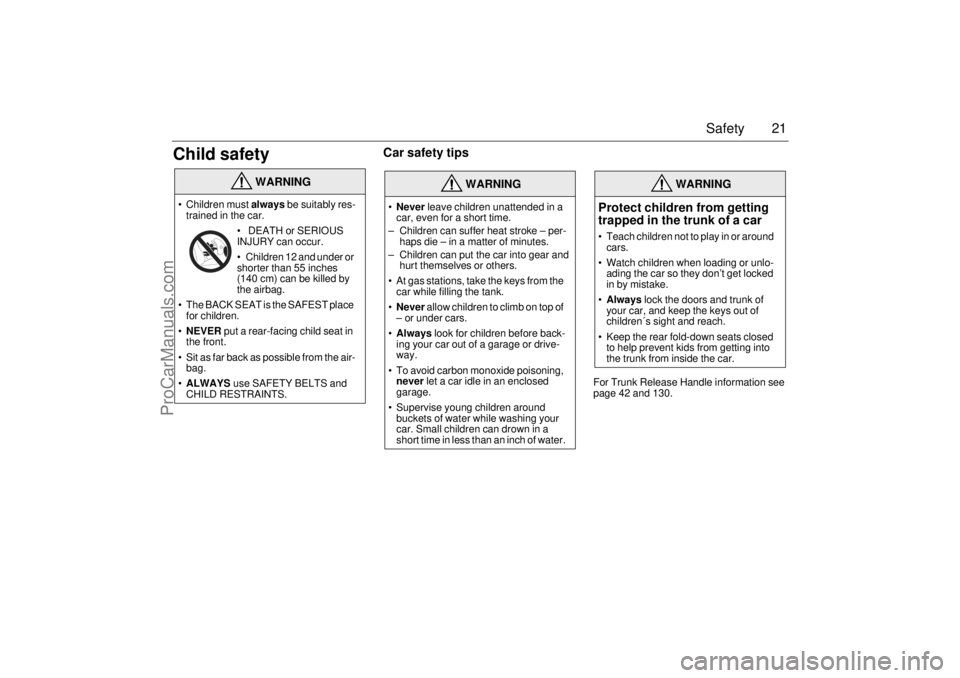
21 Safety
Child safety
Car safety tips
For Trunk Release Handle information see
page 42 and 130.
WARNING
Children must always be suitably res-
trained in the car.
DEATH or SERIOUS
INJURY can occur.
Children 12 and under or
shorter than 55 inches
(140 cm) can be killed by
the airbag.
The BACK SEAT is the SAFEST place
for children.
NEVER put a rear-facing child seat in
the front.
Sit as far back as possible from the air-
bag.
ALWAYS use SAFETY BELTS and
CHILD RESTRAINTS.
WARNING
Never leave children unattended in a
car, even for a short time.
– Children can suffer heat stroke – per-
haps die – in a matter of minutes.
– Children can put the car into gear and
hurt themselves or others.
At gas stations, take the keys from the
car while filling the tank.
Never allow children to climb on top of
– or under cars.
Always look for children before back-
ing your car out of a garage or drive-
way.
To avoid carbon monoxide poisoning,
never let a car idle in an enclosed
garage.
Supervise young children around
buckets of water while washing your
car. Small children can drown in a
short time in less than an inch of water.
WARNING
Protect children from getting
trapped in the trunk of a car Teach children not to play in or around
cars.
Watch children when loading or unlo-
ading the car so they don’t get locked
in by mistake.
Always lock the doors and trunk of
your car, and keep the keys out of
children´s sight and reach.
Keep the rear fold-down seats closed
to help prevent kids from getting into
the trunk from inside the car.
ProCarManuals.com
Page 24 of 276
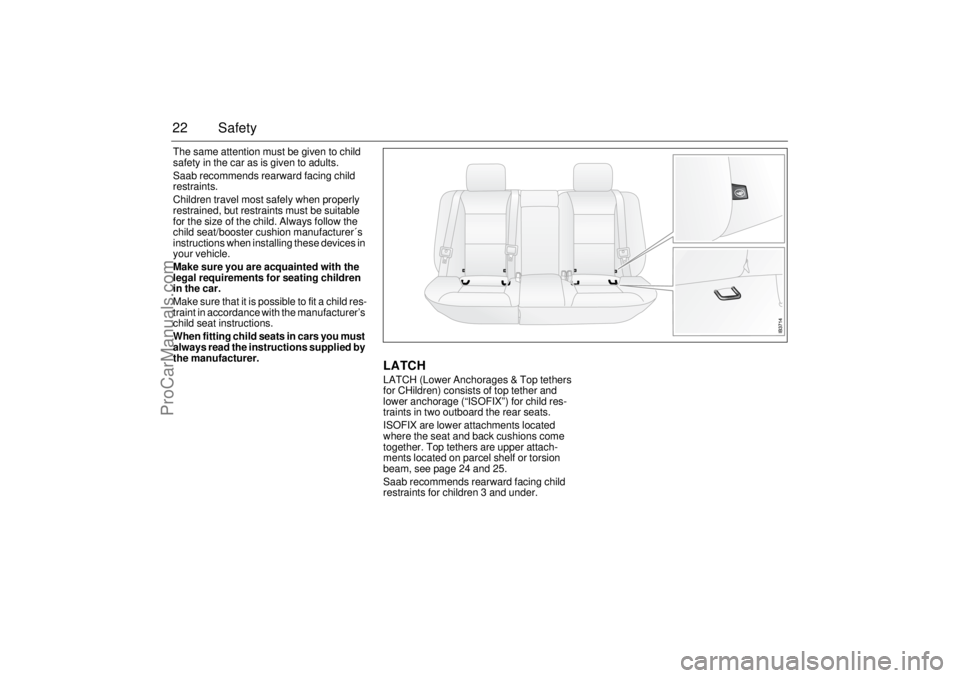
22 SafetyThe same attention must be given to child
safety in the car as is given to adults.
Saab recommends rearward facing child
restraints.
Children travel most safely when properly
restrained, but restraints must be suitable
for the size of the child. Always follow the
child seat/booster cushion manufacturer´s
instructions when installing these devices in
your vehicle.
Make sure you are acquainted with the
legal requirements for seating children
in the car.
Make sure that it is possible to fit a child res-
traint in accordance with the manufacturer’s
child seat instructions.
When fitting child seats in cars you must
always read the instructions supplied by
the manufacturer.
LATCHLATCH (Lower Anchorages & Top tethers
for CHildren) consists of top tether and
lower anchorage (“ISOFIX”) for child res-
traints in two outboard the rear seats.
ISOFIX are lower attachments located
where the seat and back cushions come
together. Top tethers are upper attach-
ments located on parcel shelf or torsion
beam, see page 24 and 25.
Saab recommends rearward facing child
restraints for children 3 and under.
ProCarManuals.com
Page 25 of 276
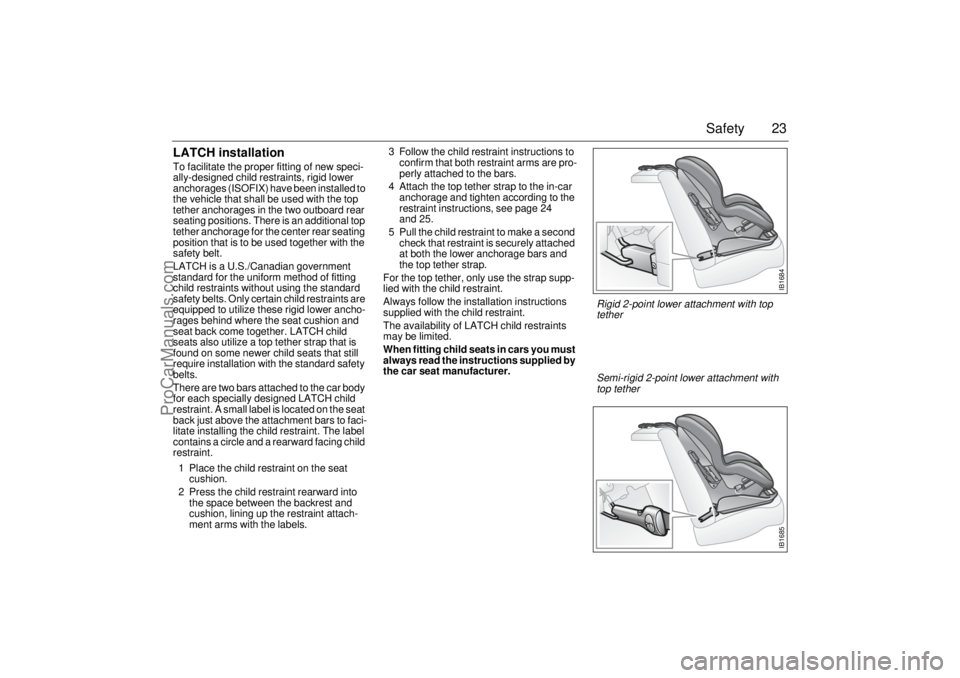
23 Safety
LATCH installationTo facilitate the proper fitting of new speci-
ally-designed child restraints, rigid lower
anchorages (ISOFIX) have been installed to
the vehicle that shall be used with the top
tether anchorages in the two outboard rear
seating positions. There is an additional top
tether anchorage for the center rear seating
position that is to be used together with the
safety belt.
LATCH is a U.S./Canadian government
standard for the uniform method of fitting
child restraints without using the standard
safety belts. Only certain child restraints are
equipped to utilize these rigid lower ancho-
rages behind where the seat cushion and
seat back come together. LATCH child
seats also utilize a top tether strap that is
found on some newer child seats that still
require installation with the standard safety
belts.
There are two bars attached to the car body
for each specially designed LATCH child
restraint. A small label is located on the seat
back just above the attachment bars to faci-
litate installing the child restraint. The label
contains a circle and a rearward facing child
restraint.
1 Place the child restraint on the seat
cushion.
2 Press the child restraint rearward into
the space between the backrest and
cushion, lining up the restraint attach-
ment arms with the labels.3 Follow the child restraint instructions to
confirm that both restraint arms are pro-
perly attached to the bars.
4 Attach the top tether strap to the in-car
anchorage and tighten according to the
restraint instructions, see page 24
and 25.
5 Pull the child restraint to make a second
check that restraint is securely attached
at both the lower anchorage bars and
the top tether strap.
For the top tether, only use the strap supp-
lied with the child restraint.
Always follow the installation instructions
supplied with the child restraint.
The availability of LATCH child restraints
may be limited.
When fitting child seats in cars you must
always read the instructions supplied by
the car seat manufacturer.
IB1684
Rigid 2-point lower attachment with top
tether
IB1685
Semi-rigid 2-point lower attachment with
top tether
ProCarManuals.com
Page 26 of 276

24 SafetyChild tether anchorages for
forward facing child car seatsChild restraints with a tether strap must be
anchored according to Canadian and USA
laws.
If you have any questions regarding child
tether anchorages please contact your
Saab dealer.9-5 Sedan:
1 Open the cover for the child tether
anchorage that is behind the seating
position in which the child restraint is to
be installed. Make sure it locks.
2 Place the child restraint in the rear seat.
3 Secure the lower part of the child res-
traint by means of the lower anchorages
(ISOFIX) or the safety belts as descri-
bed in the child restraint mounting ins-
truction.
4 Route the tether under the headrest.
5 Attach the tether to the anchorage.
6 Tighten the tether so that the back of the
child restraint is pressed hard against
the backrest.
7 Pull the child restraints to make a
second check that the restraints are
securely attached at both the lower
anchorages bars and the top tether
strap.
WARNING
Child tether anchorages are designed to
withstand only those loads imposed by
correctly fitted child restraints.
Under no circumstances are they to be
used for adult safety belts.
IB1698
Child tether anchorages in parcel shelf,
Saab 9-5 Sedan
ProCarManuals.com
Page 27 of 276
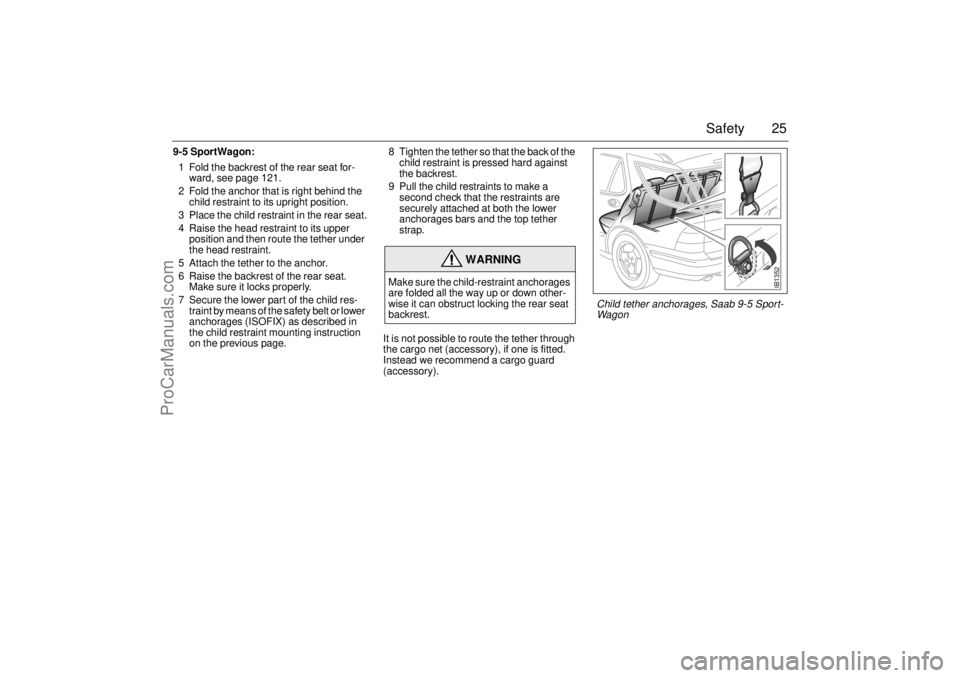
25 Safety
9-5 SportWagon:
1 Fold the backrest of the rear seat for-
ward, see page 121.
2 Fold the anchor that is right behind the
child restraint to its upright position.
3 Place the child restraint in the rear seat.
4 Raise the head restraint to its upper
position and then route the tether under
the head restraint.
5 Attach the tether to the anchor.
6 Raise the backrest of the rear seat.
Make sure it locks properly.
7 Secure the lower part of the child res-
traint by means of the safety belt or lower
anchorages (ISOFIX) as described in
the child restraint mounting instruction
on the previous page.8 Tighten the tether so that the back of the
child restraint is pressed hard against
the backrest.
9 Pull the child restraints to make a
second check that the restraints are
securely attached at both the lower
anchorages bars and the top tether
strap.
It is not possible to route the tether through
the cargo net (accessory), if one is fitted.
Instead we recommend a cargo guard
(accessory).
WARNING
Make sure the child-restraint anchorages
are folded all the way up or down other-
wise it can obstruct locking the rear seat
backrest.
IB1352
Child tether anchorages, Saab 9-5 Sport-
Wagon
ProCarManuals.com
Page 28 of 276
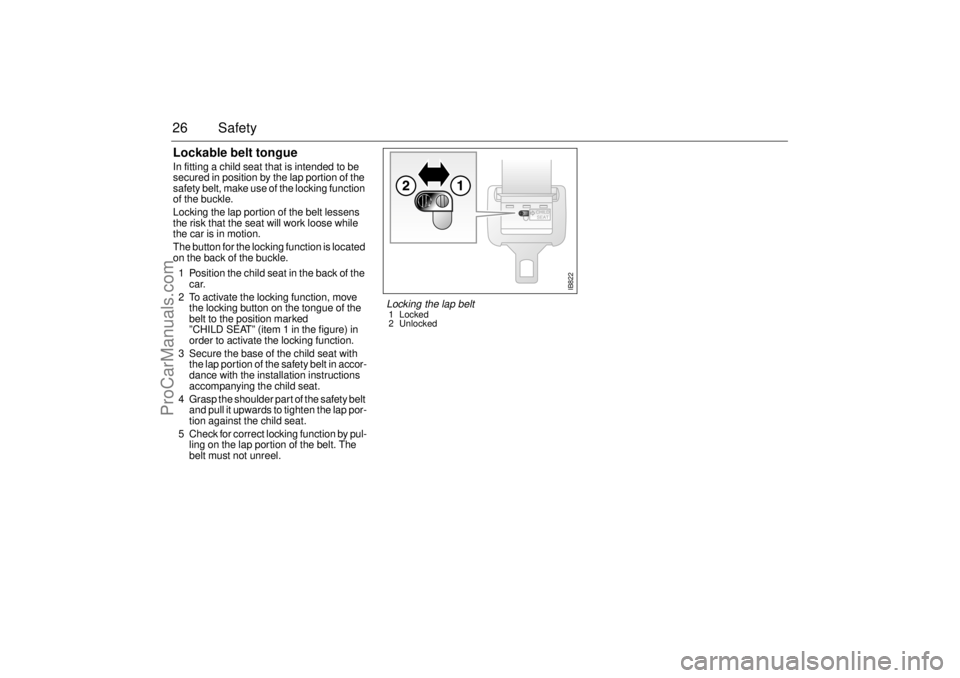
26 SafetyLockable belt tongue In fitting a child seat that is intended to be
secured in position by the lap portion of the
safety belt, make use of the locking function
of the buckle.
Locking the lap portion of the belt lessens
the risk that the seat will work loose while
the car is in motion.
The button for the locking function is located
on the back of the buckle.
1 Position the child seat in the back of the
car.
2 To activate the locking function, move
the locking button on the tongue of the
belt to the position marked
”CHILD SEAT” (item 1 in the figure) in
order to activate the locking function.
3 Secure the base of the child seat with
the lap portion of the safety belt in accor-
dance with the installation instructions
accompanying the child seat.
4 Grasp the shoulder part of the safety belt
and pull it upwards to tighten the lap por-
tion against the child seat.
5 Check for correct locking function by pul-
ling on the lap portion of the belt. The
belt must not unreel.
IB822
Locking the lap belt1 Locked
2 Unlocked
ProCarManuals.com
Page 29 of 276

27 Safety
Installation of child restraint using the
standard safety belt
Child restraints that are approved for rear-
ward facing installation in the rear seat can
be positioned in any of the three rear seating
positions.
If you intend to install another make of child
restraint make sure that it is possible to fit it
in accordance with the manufacturer’s ins-
tructions.
Saab recommends rearward facing child
restraints up to 3 years.
WARNING
Failure to follow all the manufacturer’s
instructions on the use of this child res-
traint system can cause your child to
strike the vehicle´s interior during a
sudden stop or crash.
WARNING
A special accessory is available for lock-
ing the center armrest so that a child seat
can be installed in the middle seat. See
your Saab dealer for details.
When a rear-facing child seat is fitted in
the center position of the rear seat in the
Saab 9-5 Sedan the center armrest must
be secured in place with this strap. If this
is not done, the center armrest could
swing down in the event of a frontal crash
and cause injury to the child.
IB1204
Fitting the locking strap on the center arm-
rest, Saab 9-5 Sedan (not needed on
SportWagon).
ProCarManuals.com
Page 30 of 276

28 SafetyAirbag The AIRBAG system comprises an airbag in
the steering wheel, a front passenger airbag
and side airbags in the front seats.
The system supplements the protection
provided by the safety belts to further
enhance the safety of the occupants.
If a fault is detected in the AIRBAG, the
AIR BAG warning light on the main instru-
ment panel will come on (see pages 55
and 33). When the system is triggered by impact of a
frontal crash, the airbags in the steering
wheel and passenger side of the dash board
are inflated, after which they deflate through
vents in the back of the bags.
The driver and passenger airbags are refer-
red ta as ‘smart’ airbags. This means that
the system compensates for factors such as
the force of the collision.Note:
The sensor reacts differently depending on
whether or not the front seatbelts on the dri-
ver’s and passenger sides are used. Situa-
tions can therefore arise where only one of
the airbags inflates.
It is also possible for only the seatbelt pre-
tensioners to be activated and for the air-
bags to remain uninflated.
The entire process takes less than
0.1 second – literally, faster than the blin-
king of an eye.
These airbags are triggered only by mode-
rate to severe frontal or near-frontal cras-
hes. They will not be activated by minor
front-end impacts, rear-end or side impacts,
or by the car rolling over.
WARNING
To reduce risk of injury:
Always wear your safety belt.
Always adjust your seat so that you
are as far back as possible but still
able to operate the pedals and reach
the steering wheel and controls com-
fortably.
Children 12 and under or shorter than
55 inches (140 cm) should always
travel in the rear seat as the car is fitted
with a passenger airbag.
Never fit a child seat in front of the pas-
senger airbag.
IB419
Inflated airbag (driver side) Inflation and deflation together take less than
0.1 second.
ProCarManuals.com